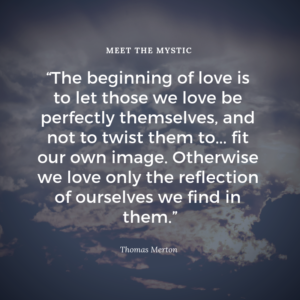Occasionally, we like to post about important people in religious history who inspire us to live better lives with more engaged faith. We’ve previously posted about Meister Eckhart.
“Mystics are people that are spiritually in-tune in different ways than your average person. They have experiences that are life-changing, yet somewhat indescribable.”
Richard Rohr, in The Naked Now, says being a mystic means, “one who has moved from mere belief systems or belonging systems to actual inner experience.”
Thomas Merton was one of the most influential religious figures of his time and one who truly moved beyond a belief system. Not only was he an advocate of social justice and peace, but he was a pioneer for interfaith engagement and his writing continues to be relevant today. He’s also a public figure of whom the state of Kentucky can actually be proud…
Having great friends from multiple religious groups, Merton was a pillar in the interfaith movement. He was interested in Zen philosophy and actually developed a great relationship with Thich Nhat Hanh. Merton’s death remains an odd tragedy; he died by accidental electrocution on a visit to Thailand that some have questioned as an assassination (by the CIA, to boot).
Merton, in a different way than Thich Nhat Hanh, teaches us about going beyond the boundaries we’ve leaned on to separate us for years and years. He is a saint for progressive Christians in the way he teaches us how much value other religious traditions bring to the world. While Merton may be explicitly talking about Christians learning from Buddhists about God, theology, and more, he teaches us lesson after lesson on how to go beyond the barriers that separate us and see one another as both humans and friends.

One of the barriers that separates us from being able to truly see one another is the way we find ourselves in the other. As humans, we seek our own image in the eyes of any other we encounter. Rather than seeing their unique qualities, we see the qualities we like in ourselves. He says, “The beginning of love is to let those we love be perfectly themselves, and not to twist them to… fit our own image. Otherwise we love only the reflection of ourselves we find in them.”
Truly loving and seeing another person requires us to see them for them. We must look beyond the qualities that catch our eyes because of their similarity to our own. We must let the other person show us themselves rather than letting us show them what they should be. We do a lot of this in our world today. Many of us who have found our way to this place, seeking to craft a meaningful faith of our own, have been hurt by someone who didn’t see us for us or who didn’t let us be ourselves. Whether it is sexual orientation, religion, race, gender, Merton teaches us that we can find so much more meaning in letting those we love “be perfectly themselves.”
In one of his great works of writing, he tells the story about standing on a street corner in Louisville, Kentucky.
He says, “In the center of the shopping district, I was suddenly overwhelmed with the realization that I loved all those people, that they were mine and I theirs, that we could not be alien to one another even though we were total strangers. It was like waking from a dream of separateness, of spurious self-isolation in a special world, the world of renunciation and supposed holiness.”
He saw people in a different way than most. What if we could see in that way? What if we woke up to truly love strangers like these? How would that change our world built on the foundations of individualism and self-isolation?